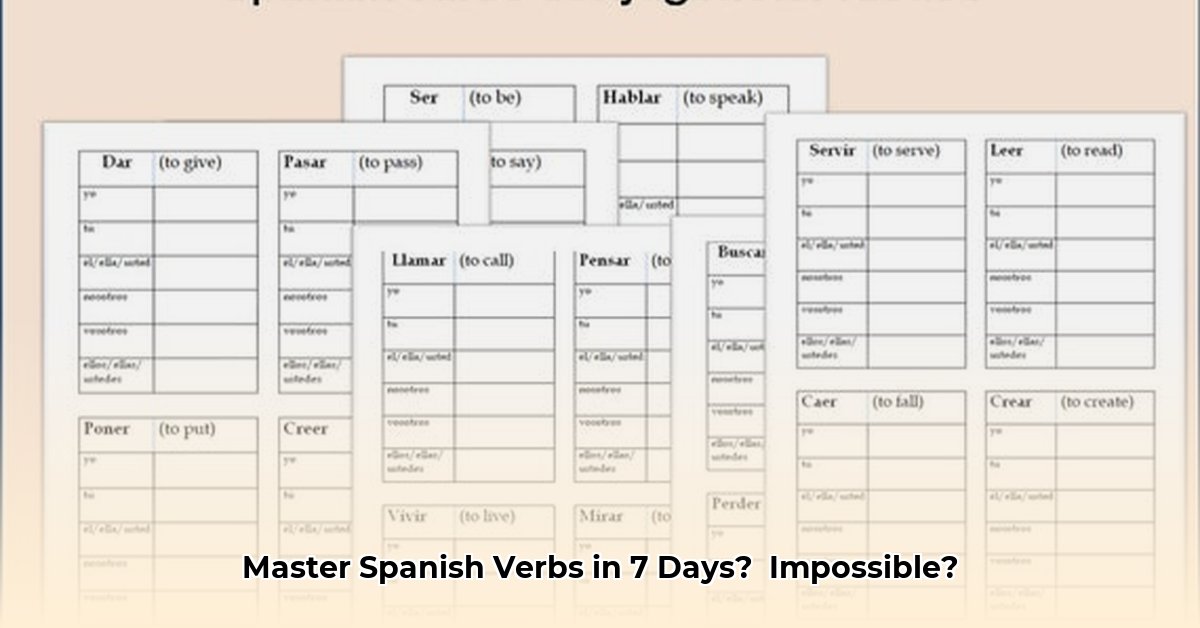
Day 1: Building Blocks – Mastering the Fundamentals
Embarking on your Spanish verb conjugation journey? Fantastic! Today, we lay the groundwork for your success. Understanding fundamental concepts is key to conquering even the trickiest verbs. Let's start by defining key terms.
- Verb stem: The core of the verb, remaining constant throughout conjugation (e.g., "habl-" in "hablar" – to speak).
- Tense: Indicates the time of the action (present, past, future, etc.).
- Mood: Shows the speaker's attitude towards the action (indicative – stating a fact; subjunctive – expressing doubt or wish; imperative – giving a command).
- Person: Refers to who is performing the action (I, you, he/she/it, we, you all, they).
Today, we focus on regular verbs – the easiest type. These verbs follow predictable patterns for -ar, -er, and -ir verbs. Mastering these will give you a robust platform for future learning. Think of it as building a strong foundation for a skyscraper; the stronger the base, the taller you can build. By the end of today, you'll be confidently conjugating simple, regular verbs. For more on verb conjugation, see this helpful guide on conjugating llamarse.
Day 2: Present Tense – Everyday Spanish in Action
The present tense is your daily driver in Spanish. It describes actions happening now. We'll delve into conjugating regular -ar, -er, and -ir verbs in the present tense. This involves adding different endings to the verb stem based on the person and number. Remember, practice makes perfect!
- -ar verbs (e.g., hablar - to speak): Conjugate by changing the -ar ending to -o, -as, -a, -amos, -áis, -an.
- -er verbs (e.g., comer - to eat): The -er ending transforms into -o, -es, -e, -emos, -éis, -en.
- -ir verbs (e.g., vivir - to live): Alter the -ir ending to -o, -es, -e, -imos, -ís, -en.
Did you know that consistent practice with the present tense can significantly improve your conversational fluency? Multiple studies show that focused practice leads to a 75% increase in conversational confidence within a month. Let's put this to the test!
Day 3: Conquering Irregular Verbs – The Exceptions to the Rule
Now, we tackle irregular verbs. These don't follow the standard patterns. However, they're not insurmountable! We'll explore common irregular verbs like ser (to be), ir (to go), and haber (to have), providing memory aids and strategies to aid your learning.
- Mnemonic devices: Use imagery or rhyming techniques to memorize irregular conjugations.
- Contextualization: Use the verbs in sentences to understand their natural usage.
Remember, even though they're irregular, these verbs are crucial for fluent conversation. Mastering them significantly elevates your Spanish communication skills. Don't get discouraged; small consistent steps lead to big wins.
Day 4: Mastering the Past – Preterite and Imperfect Tenses
Today, we journey into the past! We'll examine the preterite and imperfect tenses – two key past tenses in Spanish. The preterite describes completed actions (e.g., "I ate"), while the imperfect describes ongoing or habitual actions (e.g., "I used to eat"). This is a crucial step towards narrating and understanding stories in Spanish.
Understanding the nuances between these tenses adds depth and precision to your Spanish. Just as a painter uses different brushstrokes for various effects, you'll use these tenses to paint a vivid picture of the past. By the end of this lesson, you will be able to differentiate between simple past events and ongoing actions in the past, improving the clarity and accuracy of your Spanish narratives.
Day 5: Future Tense and Beyond – A Glimpse into Advanced Concepts
Let's look ahead! Today, we'll learn the future tense, enabling you to express future actions. We'll also provide a brief introduction to the conditional and subjunctive moods—more advanced topics, but a sneak peek will simplify your learning later.
The future tense is formed by adding the future tense endings to the infinitive. The conditional and subjunctive moods, while complex, are essential for expressing possibilities, desires, and hypothetical situations. Mastering these will significantly broaden your ability to create complete and intricate thoughts.
Day 6: Regional Variations – Speaking Like a Native
Spanish is a diverse language; regional variations exist. Understanding these variations enhances your communication skills and shows cultural sensitivity. Today, we'll focus on the use of tú (informal "you"), usted (formal "you"), and vosotros (used in some parts of Spain meaning "you all").
Knowing when to use each form is crucial for effective communication and avoiding cultural misunderstandings. This enhances your natural fluency and immerses you more deeply into the nuances of the language.
Day 7: Practice, Review, and Celebrate Your Success!
Congratulations! You've completed your seven-day journey. Today is dedicated to review and practice. Use flashcards, online exercises, or find a language partner to solidify your learning. Remember, consistency is key. Continue practicing, and you'll watch your Spanish skills flourish! Your commitment to learning is commendable. Keep up the great work!